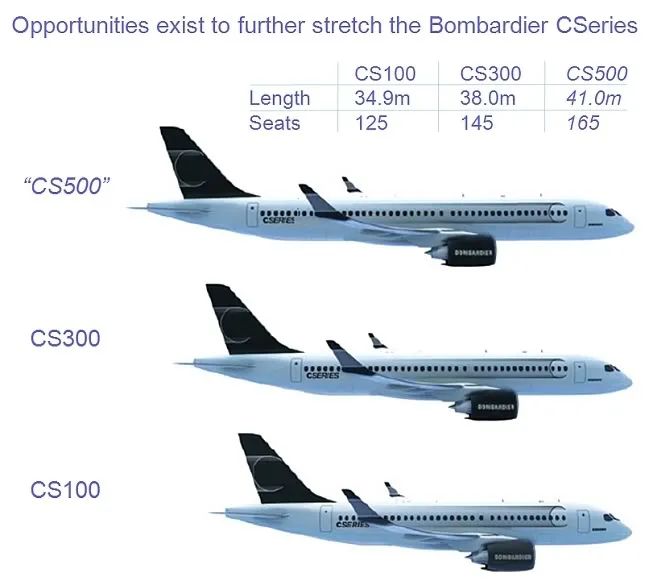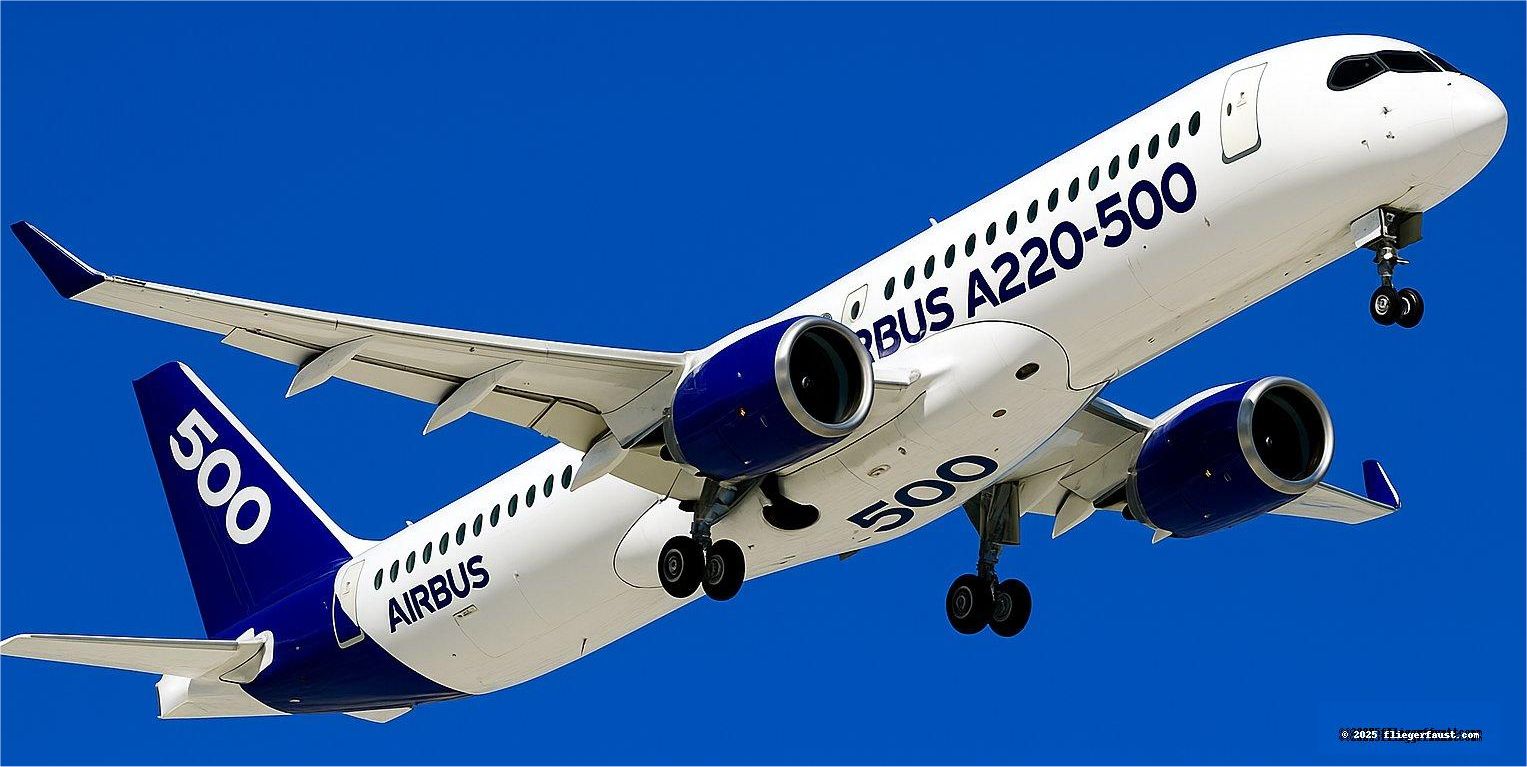Airbus A220-500: Can the Stretch Soar Without a New Wing?
Airbus A220-500—those three characters have set airline chat rooms ablaze. Can the longest-rumoured member of the A220 family really beat bigger jets on fuel burn without a costly wing redesign? Bjorn Fehrm’s two-part analysis for Leeham News (1 May 2025 and 8 May 2025) digs deep into that question, and this feature reviews his key findings, adds wider context, and points readers to his work for the full technical deep-dive.
Airbus A220-500: A Family Poised to Grow
Bombardier developed the CSeries—certified in late 2015 and entered service in 2016—to serve the 100-to-140-seat market. Airbus took charge in 2018, rebranding the CS100/CS300 as the A220-100/-300. Operators raved about the quiet cabin and lower fuel bills but soon asked for more seats.
Enter the possible Airbus A220-500—a 160-seat stretch that would sit neatly below the A320neo yet promise single-aisle efficiency to rival Boeing’s 737-8. Airbus executives have kept the idea simmering, saying only that “the market will decide.”
| Milestone | Year | Notes |
|---|---|---|
| Programme launch | July 13, 2008 | Bombardier’s board formally launched the CSeries after securing key orders. |
| First flight (CS100) | September 16, 2013 | The prototype flew from Mirabel, Quebec on 16 Sept 2013. |
| Transport Canada type certification | December 18, 2015 | Air-worthiness approval for the CS100. |
| First delivery / Entry into service | June 29, 2016 | Swiss International Air Lines received the first CS100; first revenue flight 15 July 2016. |
Fehrm’s twin articles frame the engineering riddle: Does a stretch alone preserve the jet’s efficiency edge, or must Airbus invest in a new, larger wing and more powerful engines?
Key Findings on the Airbus A220-500
Fehrm ran the numbers with Leeham’s Aircraft Performance and Cost Model (APCM). In Part 1 he benchmarked the existing A220-300 against Embraer’s E195-E2; the Airbus already wins on fuel burn per seat. The bigger puzzle was how a 160-seat version might fare.
In Part 2 he explored several stretch options:
- Fuselage stretch only. Quick and cheap but increases wing loading, trimming range by up to ten percent and lengthening take-off rolls.
- New wing only. Restores lift and runway performance, yet adds structural weight and bill-of-materials cost.
- New wing plus higher-thrust engines. Delivers A320-level range and seat-mile costs but edges close to a clean-sheet programme in complexity.
Fehrm concludes that an A220-500 seeking A320-neo parity must likely pair a slightly larger wing with 28 000 lbf engines—most probably CFM’s LEAP-1B. Readers craving the data tables should read Leeham News Part 1 (https://leehamnews.com/2025/05/01/does-an-airbus-a220-500-need-a-new-wing-and-engines/) and Part 2 (https://leehamnews.com/2025/05/08/does-an-a220-500-need-a-new-wing-and-engines-part-2).
Airbus A220-500 Supply-Chain Reality Check
A bigger jet means more structures. Airbus recently moved to acquire several Spirit AeroSystems plants to secure fuselage flow—a move explored in detail in Fliegerfaust’s coverage of the Airbus–Spirit deal. Stable supply is the first domino that must fall before any stretch can launch.
Related article: Canada’s Controversial F-35 Cancellation
Meanwhile, trade frictions could raise costs for a Canada-built aircraft shipped to Mobile, Alabama for U.S. customers. See Fliegerfaust’s trade-impact explainer for the tariff angle.
Airbus A220-500 Engine Choices Under the Microscope
Today’s A220 uses the Pratt & Whitney PW1500G, topping out near 24 000 lbf. To keep field performance with a heavier fuselage, Airbus may need 28 000 lbf. Pratt’s GTF Advantage upgrade narrows the gap, yet insiders doubt it will beat the LEAP-1B’s headline thrust.
Switching engines breaks fleet commonality and lengthens certification. Fehrm notes airlines cherish the A220’s simplicity; two engine types muddy the waters. The alternative—beefing up the PW1500G—demands a rigorous durability record after early gearbox niggles.
Environmental Stakes Rise
Airlines now face SAF mandates and carbon taxes. A composite, high-aspect-ratio wing plus new-gen turbofans could slash CO₂ per seat by a quarter versus ageing 737-800s. Fehrm’s model shows the full-upgraded A220-500 edging past the A320neo in fuel burn—welcome news for carriers under emissions caps.
Market Appetite Is Growing
Air France and airBaltic openly urge Airbus to launch the A220-500. JetBlue calls it “a sweet spot for dense leisure markets.” Low-cost carriers also watch closely: a bigger A220 promises 737-8 economics with a quieter cabin.
Yet the A320neo programme still prints money for Toulouse. Cannibalising its own bestseller requires boardroom bravery. Airbus may instead nudge the A320neo upmarket with cabin densification while letting the A220 family cover 110–160 seats.
Production Geography: Mirabel and Mobile
Current A220 final assembly lines sit in Mirabel, Québec, and Mobile, Alabama. A stretched wing could still ship from Belfast, but Airbus would need new jigs and robots. Any ramp-up must avoid the quality slips that once plagued A320neo engine fit.
Certification Marathon Ahead
A new wing changes flutter characteristics and load paths. Regulators would require full flight-test campaigns: icing, hot-high take-offs, ETOPS, and noise trials with the LEAP-1B. The FAA, EASA, and Transport Canada must align—a time-consuming dance.
Dragging those tests past 2031 would feed competitor narratives. Boeing, fighting 737 Max-10 delays, watches closely.
Love aviation news? Follow Fliegerfaust on Facebook—join the conversation and get our latest aerospace updates at facebook.com/Fliegerfaust
Fehrm’s Bottom Line—And Ours
Fehrm sees no cheap fix: “A fuselage stretch alone won’t hit the numbers.” Airbus must decide whether improved seat-mile costs justify the billions for a new wing-engine combo.
Our view? The Airbus A220-500 is a logical evolution once supply chains calm and engine reliability matures. It offers a greener step and keeps Airbus owners loyal. Still, the programme’s success hinges on timing: launch too soon and costs soar; wait too long and Boeing’s next jet may leapfrog.
Critical Question to Close
Will Airbus commit to the A220-500 with the full upgrades Fehrm deems essential, or will short-term cost caution keep the market waiting?
Either way, Bjorn Fehrm’s twin analyses set the benchmark for judging every rumour until Toulouse finally shows its hand.

Stay in the flight deck with real-time updates—follow @theFliegerFaust on X (Twitter): https://x.com/theFliegerFaust

